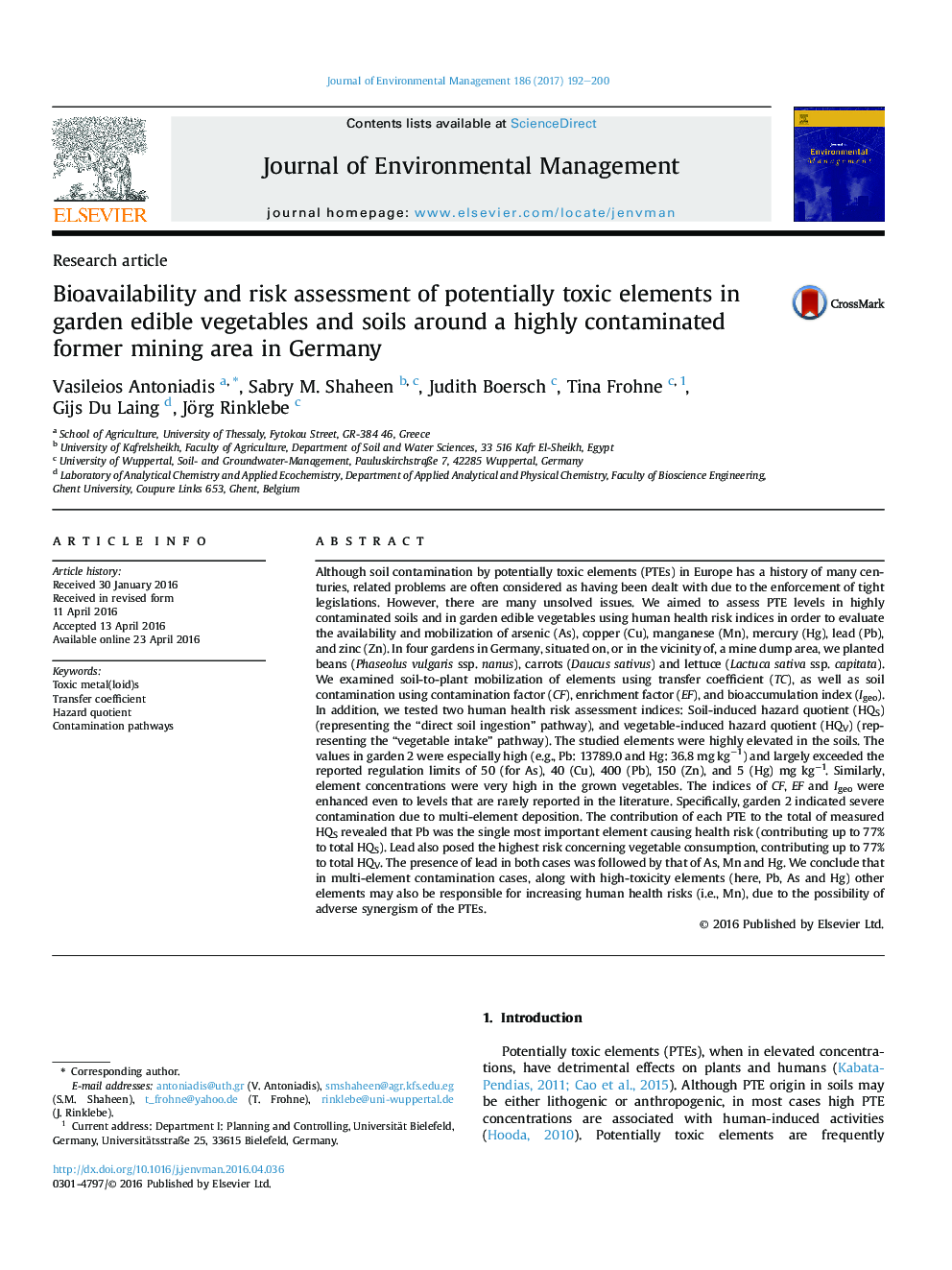| کد مقاله | کد نشریه | سال انتشار | مقاله انگلیسی | نسخه تمام متن |
|---|---|---|---|---|
| 5117418 | 1378125 | 2017 | 9 صفحه PDF | دانلود رایگان |
عنوان انگلیسی مقاله ISI
Bioavailability and risk assessment of potentially toxic elements in garden edible vegetables and soils around a highly contaminated former mining area in Germany
ترجمه فارسی عنوان
قابلیت دسترسی بیولوژیک و ارزیابی ریسک عناصر بالقوه سمی در سبزیجات و سبزیجات خوراکی در اطراف منطقه معدن سابق آلوده در آلمان
دانلود مقاله + سفارش ترجمه
دانلود مقاله ISI انگلیسی
رایگان برای ایرانیان
کلمات کلیدی
فلز سمی (آرام)، ضریب انتقال، فاکتور خطر مسیرهای آلودگی،
موضوعات مرتبط
مهندسی و علوم پایه
مهندسی انرژی
انرژی های تجدید پذیر، توسعه پایدار و محیط زیست
چکیده انگلیسی
Although soil contamination by potentially toxic elements (PTEs) in Europe has a history of many centuries, related problems are often considered as having been dealt with due to the enforcement of tight legislations. However, there are many unsolved issues. We aimed to assess PTE levels in highly contaminated soils and in garden edible vegetables using human health risk indices in order to evaluate the availability and mobilization of arsenic (As), copper (Cu), manganese (Mn), mercury (Hg), lead (Pb), and zinc (Zn). In four gardens in Germany, situated on, or in the vicinity of, a mine dump area, we planted beans (Phaseolus vulgaris ssp. nanus), carrots (Daucus sativus) and lettuce (Lactuca sativa ssp. capitata). We examined soil-to-plant mobilization of elements using transfer coefficient (TC), as well as soil contamination using contamination factor (CF), enrichment factor (EF), and bioaccumulation index (Igeo). In addition, we tested two human health risk assessment indices: Soil-induced hazard quotient (HQS) (representing the “direct soil ingestion” pathway), and vegetable-induced hazard quotient (HQV) (representing the “vegetable intake” pathway). The studied elements were highly elevated in the soils. The values in garden 2 were especially high (e.g., Pb: 13789.0 and Hg: 36.8 mg kgâ1) and largely exceeded the reported regulation limits of 50 (for As), 40 (Cu), 400 (Pb), 150 (Zn), and 5 (Hg) mg kgâ1. Similarly, element concentrations were very high in the grown vegetables. The indices of CF, EF and Igeo were enhanced even to levels that are rarely reported in the literature. Specifically, garden 2 indicated severe contamination due to multi-element deposition. The contribution of each PTE to the total of measured HQS revealed that Pb was the single most important element causing health risk (contributing up to 77% to total HQS). Lead also posed the highest risk concerning vegetable consumption, contributing up to 77% to total HQV. The presence of lead in both cases was followed by that of As, Mn and Hg. We conclude that in multi-element contamination cases, along with high-toxicity elements (here, Pb, As and Hg) other elements may also be responsible for increasing human health risks (i.e., Mn), due to the possibility of adverse synergism of the PTEs.
ناشر
Database: Elsevier - ScienceDirect (ساینس دایرکت)
Journal: Journal of Environmental Management - Volume 186, Part 2, 15 January 2017, Pages 192-200
Journal: Journal of Environmental Management - Volume 186, Part 2, 15 January 2017, Pages 192-200
نویسندگان
Vasileios Antoniadis, Sabry M. Shaheen, Judith Boersch, Tina Frohne, Gijs Du Laing, Jörg Rinklebe,
